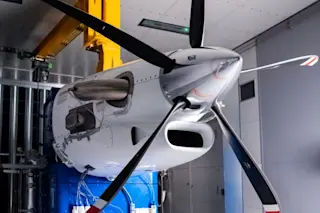Yesterday morning, about 70,000 feet over the Pacific Ocean, the Boeing-designed X-51A Waverider "scramjet" set a new record. Reaching Mach 5 (almost 4,000 miles per hour), it wasn't the fastest jet flight, but by burning for over 200 seconds it became the longest flight of its kind. The previous scramjet record, held by the NASA X-43, was 12 seconds. A scramjet is similar to a simpler engine called a ramjet, but faster. The engines on most commercial jets have turbines to push air inside, but a ramjet is basically a tapered tube. As air flows through it, the shape of the tube compresses the air and, once the engine mixes this air with fuel, it ignites.
Unlike well-understood ordinary ramjets, which slow the air passing through them to subsonic speeds, the X-51 is intended to maintain combustion in a supersonic internal airflow -- hence the name scramjet, for supersonic combustion ramjet -- a feat often likened to "striking a match in a hurricane". [The Register]
Since it needs moving air to fire, a ramjet can't start from a standstill. Yesterday, a NASA-operated B-52 Stratofortress took the unmanned jet under its wing and dropped it at about 50,000 feet. Then a solid rocket booster accelerated the X-51 to about Mach 4.5. Then, on its own power, the scramjet climbed 20,000 feet, accelerated to Mach 5, and burned it engine for a total flight time of about 200 seconds.
"We are ecstatic to have accomplished most of our test points on the X-51A's very first hypersonic mission," said Charlie Brink, a X-51A program manager with the Air Force Research Laboratory at Wright-Patterson Air Force Base, Ohio. "We equate this leap in engine technology as equivalent to the post-World War II jump from propeller-driven aircraft to jet engines." [U.S. Air Force]
NASA's X-43A scramjet still holds the record for fastest jet engine flight, achieving about a 12 second run at Mach 9.6 in 2004. But the X-43A used hydrogen, which would require huge tanks if the jet found commercial use. The X-51A does not have this liability; it uses an easier-to-carry hydrocarbon fuel.
Joe Vogel, Boeing's director of hypersonics, said, "This is a new world record and sets the foundation for several hypersonic applications, including access to space, reconnaissance, strike, global reach and commercial transportation." [Washington Post]
Related content: DISCOVER: Cheaper Rides Into Space DISCOVER: It's 2008. Here's Your Jet Pack 80beats: DARPA Wants a Biofuel Jet, While Germany Works on a Hydrogen Plane 80beats: Super-Green, Algae-Derived Jet Fuel Passes Tests With Flying Colors 80beats: DARPA Loses Contact with Mach 20 “Hypersonic Glider” During Test Flight













